国际商务谈判-简答题
市场营销自考国际商务谈判的单选、多选和简答集合

一、单项选择题1。
按谈判中双方所采取的的态度,可以将谈判分为立场型谈判、原则型谈判和软式谈判。
2.在商务谈判中,双方地位平等是指双方在法律上的平等。
3.价格条款的谈判应由商务人员承提。
4。
市场信息的语言组织结构包括文字式结构和数据式结构.5。
根据谈判者让步的程度,谈判风格可分为软弱型模式、强有力模式和合作型模式。
6.在国际商务谈判中,有两种典型的报价战术,即西欧式报价和日本式报价。
7.在缺乏谈判经验的情况下,进行一些较为陌生的谈判,谈判人员应采取等额的让步方式。
8.商务谈判中,作为摸清对方需要,掌握对方心理的手段是问.9.谈判中的讨价还价主要体现在辩上。
10.谈判中最为纷繁多变,也是经常发生破裂的阶段是谈判中期.、11.国际商务谈判中,非人员风险主要有政治风险、自然风险和市场风险。
、12。
谈判中,双方互赠礼品时,西方人较为重视礼物的意义和感情价值.13。
谈判中以与别人保持良好关系为满足的谈判心理属于是关系型.14。
英国人的谈判风格一般表现为按部就班.15.日本人的谈判风格一般表现为集团意识强。
1。
所有导致谈判僵局的谈判主题中,价格是最为敏感的一种。
2。
谈判前,主要迎送人的身份、地位与来者应该对等。
3.由买方主动作出的发盘,国际上称为递盘。
4。
谈判中表达难以接受或不满时,通常用升调.5。
预见风险和控制风险两者关系是成正比.6。
意会最有可能成为无效的信息传递方式.7。
若某谈判者性格外露、坦率、豪爽、自信、追求物质利益,则他最可能是美国人. 8。
若筹资时市场利率较低,并有回升趋势,则应争取借入固定利率的长期借款。
9.“打持久战”时情绪型的人最不适用。
10。
说明是谈判中最艰巨、复杂和富有技巧性的工作. 11.在进行商务条款的谈判时,商务人员是主谈人。
12。
让步型谈判者把对方不当作敌人,而看作朋友。
13.对重要的问题应争取在主场进行。
14。
若对方对本次交易的行情不了解,则我方可选择先报价。
15。
“你看给我方的折扣定为3%是否妥当?”这句话属于协商式发问。
全国高等教育自学考试《国际商务谈判》历年试题简答题汇总及答案

全国高等教育自学考试《国际商务谈判》试题简答题汇总及答案课程代码:00186四、简答题(本大题共5小题,每小题6分,共30分)2008年10月30.简述PRAM谈判模式的构成。
1-17/1931.典型的谈判议程主要包括哪些内容?3-111/11232.打破谈判中僵局的做法有哪些?4-174/17533.说服谈判中的顽固者的技巧有哪些?5-232/23334.规避国际商务合作中风险的措施通常有哪些?7-3102009年1月30.简述谈判的入题技巧。
5-21431.简述影响国际商务谈判中群体效能的主要因素。
2-47/4932.迫使谈判对手让步的策略主要有哪些?4-155/15833.简述谈判的实际需求目标的特点。
3-10434.简述俄罗斯商人的谈判风格。
6-2712009年10月30.国际商务谈判与一般贸易谈判的共性体现在哪些方面?1-531.谈判中,有效的防守策略主要有哪些?4-159/16032.简述影响国际商务谈判的政治状况因素。
2-26/2833.阐述的技巧包括哪些?5-216/22034.简述应对利率风险的技术手段。
7-3192010年1月30.国际商务谈判的特殊性有哪些?1-5/631.简述与国际商务谈判有关的财政金融状况因素。
2-33/3432.简述国际商务谈判队伍的人员层次及其分工。
3-69/7133.简述商务谈判中潜在僵局的间接处理法。
4-170/17134.简述商务谈判中提问的要诀。
5-208/2092010年10月30.国际商务谈判的特殊性有哪些?1-5/631.简述国际商务谈判中宗教信仰因素的影响。
2-2932.在谈判的开局阶段如何交换意见?4-13233.简述商务谈判中阻止对方进攻的策略。
4-159/16034.简述商务谈判中提问时应注意的问题。
5-209/2102011年1月30.国际商务谈判与一般贸易谈判有哪些共性?1-531.简述国际商务谈判的常见法律问题。
2-37/4032.开局阶段,谈判双方的实力通常包括哪几种情况?4-13533.简述适当的让步策略。
国际商务 简答题及答案
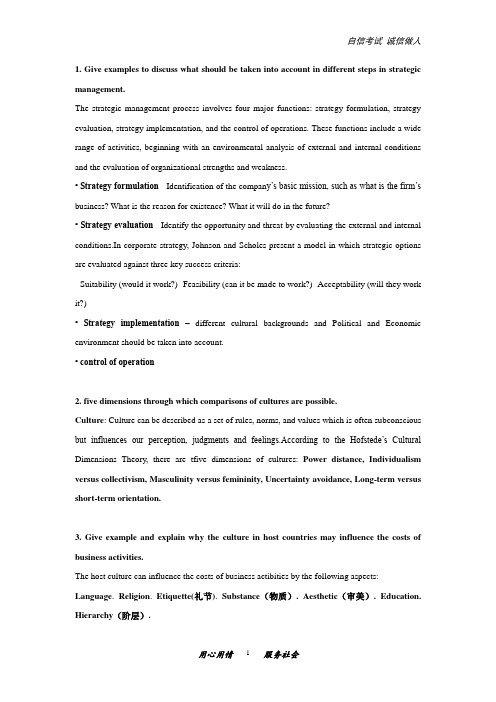
1. Give examples to discuss what should be taken into account in different steps in strategic management.The strategic management process involves four major functions: strategy formulation, strategy evaluation, strategy implementation, and the control of operations. These functions include a wide range of activities, beginning with an environmental analysis of external and internal conditions and the evaluation of organizational strengths and weakness.• Strategy formulation - Identification of the compan y’s basic mission, such as what is the firm’s business? What is the reason for existence? What it will do in the future?• Strategy evaluation - Identify the opportunity and threat by evaluating the external and internal conditions.In corporate strategy, Johnson and Scholes present a model in which strategic options are evaluated against three key success criteria:- Suitability (would it work?)- Feasibility (can it be made to work?)- Acceptability (will they work it?)• Strategy implementation–different cultural backgrounds and Political and Economic environment should be taken into account.• control of operation2. five dimensions through which comparisons of cultures are possible.Culture: Culture can be described as a set of rules, norms, and values which is often subconscious but influences our perception, judgments and feelings.According to the Hofstede’s Cultural Dimensions Theory, there are tfive dimensions of cultures: Power distance, Individualism versus collectivism, Masculinity versus femininity, Uncertainty avoidance, Long-term versus short-term orientation.3. Give example and explain why the culture in host countries may influence the costs of business activities.The host culture can influence the costs of business actibities by the following aspects: Language.Religion. Etiquette(礼节). Substance(物质). Aesthetic(审美). Education. Hierarchy(阶层).4. The relationship between globalization and regional economic integration.(1) There are many differences between globalization and regional economic integration:- Globalization relies mainly on scientific and technological progress, transnational economic, capital and markets, as well as the promotion of market mechanism,which is dominated by market mechanism. Meanwhile, regional economic integration aims to regional economic coordination, balance and orderly development of the objective. - Globalization unites the world through the market mechanism, but regionalization unites the world through the negotiation and agreement between the governments.- In the state of global free market, it is difficult to avoid the risk; while in the state of regionalization, risk can get controlled and eliminated.(2)Regional economic integration is the only way to achieve economic globalization.(3)Regional economic integration is a second best option.(4)BUT the impediment to globalization stem from regional economic integration is more evident.(5) globalization and REI would come to the same end, although they are contradicted.5. The major achievements of European economic integration.A growth in economic power It is the largest economy in the world by nominal GDP and the second largest trade bloc economy in the world by PPP valuation of GDP. It is also the largest exporter , and largest importer of goods and servicesSingle market build in 1992 Free movement of goods、persons、services、capitalCommon agricultural policy. The CAP was created in 1957 under the Treaty of Rome and started operating in 1962. The EEC member countries have transferred some of their law-making authority to the EU in certain policy areas.Monetary union 16 EU countries have introduced the euro as their sole currency. The creation of a European single currency became an official objective of the EU in 1969. With the advent of the Maastricht Treaty in 1993 , member states were legally bound to start the monetary union no later than 1 January 1999.Budget The European Union has established a common budget system.Competition The EEC operates a competition policy intended to ensure undistorted competition within the single market. The Commission as the competition regulator for the single market isresponsible for antitrust issues, approving mergers, breaking up cartels, working for economic liberalization and preventing state aid.6. Please discuss the drivers and characteristics of globalization.Globalization means an increasingly interconnected world, as a result of very rapid increases in telecommunications and computer-based technologies and products, a dramatic expansion in cross-border financial flows and within countries has emerged.Two macro factors underlie the trend toward greater globalization. The first is the decline in barriers to the free flow of goods,services,and capital that has occurred since the end of world war two.The second factor is technological change, particularly the dramatic developments in recent years in communication,information processing, and transportation technologies.(1)There are five broad groups of industry globalization drivers as below:Market Drivers、Technological driver、Cost drivers、Political Drivers、Competitive Drivers (2)The characteristics of globalization can be reflected from the following aspects:Trade liberalization、Financial liberalization、Production integration7. What may be the motivations of Merger and Acquisition and what cautions should be taken in A&M?Motivation for mergers and acquisition:(1)Synergy motivations is created from economies of integrating a target and acquiring a company; the amount by which the value of the combined firm exceeds the sum value of the two individual firms.(2)Value Creation Motivations- Economies of Scale: Reducing capacity, spreading fixed costs, geographic synergies- Economies of Scope: Combination of two activities reduces costs- Complementary Strengths: Combining the different relative strengths of the two firms creates a firm with both strengths that are complementary to one another.- Efficiency Increases: New management team will be more efficient and add more value than what the target now has; the combined firm can make use of unused production/sales/marketing channel capacity.- Financing Synergy: Reduced cash flow variability, increase in debt capacity, reduction in average issuing costs, fewer information problems.- Tax Benefits Make better use of tax deductions and credits- Strategic Realignments: Permits new strategies that were not feasible for prior to the acquisition because of the acquisition of new management skills, connections to markets or people, and new products/services.(3)Managerial Motivations- Increased firm size Managers are often more highly rewarded financially for building a bigger business- Reduced firm risk through diversification M&As can be used to diversify the company and reduce volatility (risk) that might concern managers.Cautions to take:1.Evaluate the attractiveness and potential profits of target firm’s industry.2.Don’t violate the law of the country where target firm exist.3.Pay attention to the capital structure and make sure the full control of the merged company.4.Try to mitigate the host country's national consciousness and overcome the cultural differences within the enterprise.5.The transaction risk would bring a large sum of loss because of the fluctuating macro-environment.8. Why do more and more MNCs establish strategic alliances with other firms?Strategic alliances refer to cooperative agreements between potential or actual competitors.Firms ally themselves with potential or actual competitors for various strategic purposes.First,strategic alliances may facilitate entry into a foreign market.Through the strategic alliance,MNCs can expand the market space to achieve scale economy in the wider market range. Second,strategic alliances allow firms to share the fixed costs and associated risks of developing new products or processes.Third,an alliance is a way to bring together complementary skills and assets that neither company could easily develop on its own.It helps MNCs promote the learning ability of organization, develop core competitiveness, and strengthen the long-term competitive advantage.Fourth,it can make sense to form an alliance that will help the firm establish technological standards for the industry.Once a kind of technology turns to an industry standard, it can get huge network monopoly earnings,help the firm achieve market leading position and market manipulation of power that will benefit the firm.9. Please argue for the importance or/and unimportance of “strategy”.Strategy is a set of action that managers adopt to help the company achieve its goal. A clear strategy can help companies participate in the competition more effectively in competitiveinternational market; It can also help to coordinate activities of all different departments in the company to complete the whole goal by most efficient way. (1) strategy can make the enterprise achieve their strategic objectives in a planned way Strategic goal shows the direction level that the enterprise want to obtain in a certain period of the production and business operation activities. According to their strategic thought, strategy helps enterprises achieve the expected target in their development direction and path.Under the consideration of the changes in the external environment and the characteristics of the enterprise,each enterprise should puts forward the principle of its own special style to promote the development of the enterprise.(2)strategy can make enterprise management decision scientific and systematic Correct decisions can lead to good economic effect and promote the development of the enterprise.Through the strategy formulation, implementation, evaluation and control, enterprise management decision is scientific and systematic, then establishs a complete organism to adapt to the enterprise changes in the external environment.(3) strategy can make effective use of resources to achieve the optimal objective Based on fully research of internal conditions and external environment of enterprise, strategy must balance effective configuration of both internal business resources and external environment resources in order to seek the long-term development of the enterprise and the optimization of system target. (4) strategy can enhance the competitive ability of enterprises in the market Through the information feedback system and the analysis of the enterprise internal and external environment,enterprises can adjust strategy to improve capability in time. Strategy helps to keep the enterprise dynamic adaptability to the environment and relative stability, so as to improve the enterprise permanence competitive ability.In short,strategy is very important for enterprises' management.10. Discuss the merits and demerits of core competence strategy and diversification strategy. Core competence: The knowledge and skills integrated(整合) Within an organization, especially about how to coordinate a variety of production skills and to integrate knowledge and skills of different technologies.The merits of core competence strategy:1) Be better to concentrate all the enterprise’s resource, which serves for the specific objective2)Objectives are focused on specific markets, so that the company could invest some technology, market, consumers and competitors of the core products in a more effective method3) Core competence is inimitability. Core competence has became a source of sustainable competitive advantage. because of its core competence, the enterprises can survive from the fierce competition.4)The strategy is clear; effectiveness of business is more convenient to calculate and it is easier to control the strategy management.The demerits of core competence strategy:1)When consumers’ preference has changed, the company couldn’t gather enough resource to gain these new markets, because all the resource is spent in the specific objective, and the company is hard to transfer these resources to new fields2)The competitors enter the enterprise’s specific objective market, and they take better strategy than the enterprise’s core competence strategy3)With upgrade of the core product, cost of production increases, which leads to the weakness of the core competence strategy’s meritsDiversification strategyThe merits of diversification strategy:1)The enterprise could transfer the exclusive skills, production skills and technology from one operating to another2)The enterprise could combine different operating businesses, which reduces the cost 3)The enterprise could take advantage of the precious brand in new operating businesses4)The enterprise could implement the value chain activities related to building valuable competenceThe demerits of diversification strategy:1)When the company decides to enter new field, it always faces vast risk of related operating2)As the company distributes the limited resources to different operating businesses, it is difficult for the company to deal with conflict between multiple objectives and limited resources3)If the enterprise makes a mortal mistake in one of operating businesses and could not disinvestment from that, the mistake might lead the company to jeopardize11. Compare the different characteristics of multidomestic strategy and global strategy.1)Multidomestic strategy is subject to low cost pressures, but need to adapt locally.Example: GM with respect to European operations. By contrary, Global strategy is subject to high cost pressures and little necessity to adapt locally (standardize)Example: Semi-conductor industry: Intel and Motorola.2)When you come to talk about Multidomestic strategy, its Strategy and operating decisions are decentralized to strategic business units (SBU) in each country. But in global strategy, Decisionsregarding business-level strategies are centralized in the home office. In a word, global strategy requires more centralized decision-making than multidomestic strategy does.3)Products and services in multidomestic strategy are tailored to local markets, while in global strategy Products are standardized across national markets.4)Business units in one country in multidomestic strategy are independent of each other, while in global strategy, the Strategic business units (SBU) are assumed to be interdependent.5)Multidomestic strategy assumes markets differ by country or regions, and focus on competition in each market; Global strategy emphasizes economies of scale and often lacks responsiveness to local markets.6)Multidomestic strategy is a kind of prominent strategy among European firms due to broad variety of cultures and markets in Europe, but Global strategy still requires resource sharing, coordination across borders (which makes it difficult to manage), and more centralized decision-making than multidomestic strategy does.12. What are the international business risks and how to manage these risks?Many risks in business have to be considered so that entrepreneurs could prolong their lives in the business arena. Factors such as national laws, political situations, international treaties as well as globalization should be taken in consideration since they could directly affect international business transactions in one way or another.The risks of doing business are determined by a number of political, economic, and legal factors:Political risk is the likelihood that political forces will cause drastic changes in a country's business environment that adversely affects the profit and other goals of a business enterprise. Economic risk is the likelihood that economic mismanagement will cause drastic changes in a country's business environment that adversely affects the profit and other goals of a business enterprise. Legal risk is the likelihood that a trading partner will opportunistically break a contract or expropriate property rights.To reduce the risk of government intervention, the international firm needs to demonstrate that it is considered with the host country's society and that it considers itself an integral part of the host country,rather than simply an exploitative foreign corporation.Ways of doing this include intensive local hiring and training practices,better pay,contribution to charity and usefulinvestments for the society.Another action that can be taken by corporations to protect against political risk is the close monitoring of political development.Firms can also take out insurance, like OPIC(海外私人投资公司), to cover losses due to political and economic risk.At the same time,Foreign Exchange Risk is a major international business risk.It includes transaction exposure,accounting exposure and operation exposure. A firm that insures itself against foreign exchange risk is hedging.Firms can hedge their risk by entering into forward contracts to purchase the necessary currency and lock in the exchange rate, but this will also raise costs.They can also use a leading and lagging(提前错后支付),parallel loan(平行贷款)or currency swap(货币兑换)to lessen their risk.13. How can a firm use international capital markets?The international capital markets gathers different borrowers and lenders in the domestic capital market of each country, whose growth has created opportunities for international business that wish to borrow and/or invest money. On the borrow side, by using the international capital markets,firms can often borrow funds at a lower cost than is possible in a purely domestic capital market. When a firm cannot acquire the fund in domestic capital market, it can turn to the foreign ones in the international capital markets, and obtain the opportunity which seems impossible within the domestic capital market. If domestic capital competition is too fierce, expand monetary supply still can make those enterprises which are small but full of potential benefit from it. At the same time, expand monetary supply can decrease the cost of loans, because just like other commodities, monetary has the price itself. According to Market demand and supply mechanism, the more supply of capital,the lower interest rate. This conclusion holds no matter what form of borrowing a firm uses——equity, bonds,or cash loans.The lower cost of capital on the international markets reflects their greater liquidity and the general absence of government regulation. Balanced against this, however, is the foreign exchange risk associated this borrowing in a foreign currency.On the investment side, international capital market broaden new avenues for enterprise financing. The growth of the international markets is providing opportunities for firms to diversify their investment to limit risk. By holding a diverse portfolio of stocks and bonds in different nations, whose price changes independently, the firm can reduce total risk to a lower level thanthat can be achieved in a purely domestic setting. Once again, however, foreign exchange risk is a complicating factor. This means that, while enterprises make full use of the advantage of international capital market, they must strengthen the management of foreign exchange risk.Firms must balance the foreign exchange risk associated with borrowing in foreign currencies against the costs savings that may exist.14. Describe the new trends of MNCs strategy and structure and explain the reasons.[flat(cost↓efficiency↑), flexible(sensible to market), network( IT to innovation + management]∵enterprise competition environment change and organization skills development needs,∴multinational companies have reinforced the organization structure, it presents a Flattening , flexibility and the trend of the network.1.Flattening traditional : a pyramid structure, present : FlatteningTo reducing the management level and cut the excess of employees to set up a contracted structure. For improve the efficiency of the organization skills.∵Through this way, the enterprise delegates to employees, stimulate staff motivation, staff training independent work and coordination ability, which established a new type of service relationship.2. flexibility Be sensible to the modern market demand, try to use organizational structure to adapt to the modern high flexible production technology.3. network management structure: economic globalization + international InternetUse the IT skill to achieve resource management and information exchange. Emphasize IT helps to improve efficiency and get win-win innovation. It helps to manage subsidiaries all around the world.15. How to select and manage the strategic alliance partners?Selection = conduct researches on potential alliance candidates.1) collect information2) gather data from informed third parties ( firms,investment bankers,former employees)3) Try to get to know possible4) face-to-face meetingsAlliance StructureOnce a partner has been selected, the alliance should be structured: to make it difficult to transfer technology not meant to be transferred;with contractual safeguards written into the alliance agreement to guard against the risk of opportunism by a partner;to allow for skills and technology swaps with equitable gains ;to minimize the risk of opportunism by an alliance partner. Management1) sensible to cultural differences + building trust2) interpersonal relationships (relational capital)3) learn from its alliance partner (partner`s strengths and weaknesses + technology )16. Why do more MNCs establish strategic alliances with domestic firms and firms from abroad?1. definition cooperative agreements between potential or actual competitors.2. 1) facilitate entry into a foreign market.Many fast-growth technology companies use strategic alliances to benefit from more-established channels of distribution, marketing, or brand reputation of bigger, better-known players. They can achieve geographic expansion, cost reduction, manufacturing, and other goalsthrough the strategic alliance. What`s more, they can achieve scale economy in the wider market range.2) share the fixed costs and risks of developing new products. Gain access to a partner's resources (markets, technologies, capital and people). So as to save time and boost productivity, leading to grow more efficiently. They can concentrate on innovation and their core business.3) bring together unique skills and assets (hard to develop by its own).promote the learning ability of organization, develop core competitiveness, and strengthen the long-term competitive advantage.4) establish technological standards for the industry. Once technology → industry standard= get huge network monopoly earnings, help the firm achieve market leading position17. Organizational structure has three dimensions:1. Vertical differentiation - the location of decision-making responsibilities within a structure2. Horizontal differentiation - the formal division of the organization into sub-units3. The establishment of integrating mechanisms - the mechanisms for coordinating sub-units18. What factors should be taken into account when firms select foreign entry modes?②macro-environment. Good : political stability, liberal investment policy, high national income and the stable exchange rate= take investment patterns③Geography and social cultural environment. a. the distance between domestic and the target countries is far= contract models or investment mode. For saving the cost of the long-distance transportation b. social culture is different = export mode or contract models. For avoid the culture clashes .Materials, labor, capital market, infrastructure, etc) easily acquired and prices. c. production elements and the prices are low, infrastructure is perfect = investment or export mode.①The size and competition structure of the marketc. market structure : extensive market competition degree : higher=the export modelb. competition structure : monopoly type,= contract models or investment patterns For: enough ability and strength to compete against the enterprise in local.a. market size : in large scale / great market potential,= using investment patterns to enter the market, Or export mode and contract models, For: the efficient use of the enterprise resources.⑦Enterprise resources and input factor.a. If enterprise has abundant resources in management, capital, technology, process, and sales,the enterprise has more choice in choosing entry mode.b. If the enterprise has sufficient resource,it can take export mode and contract models. After the enterprise gain international marketing experience, it can change their mode to direct investment mode.⑥Core competitiveness of the enterprise. As to core competitiveness, the enterprise can be divided into two kinds: the technological competitiveness and management skill.b. the technological competitiveness. Avoid : licensing agreements and joint venture. For reduce the possibility of technology out of control.c.management skill.take the franchise and set up subsidiaries method. For protect their brand⑤Enterprise products factors.a. Labor-intensive and resource-intensive products :choose the country with rich natural resources as production base= take the investment mode. For save the middle export costs.c. the product post-sale service demand : higher= take contract models or investment patterns.19. Discuss the positive and negative effects of outward FDI on home country.Outflows of FDI are the flows of FDI out of a countryThere are four main benefits of inward FDI for a host country:1. resource transfer effects - FDI can make a positive contribution to a host economy by supplying capital, technology, and management resources that would otherwise not be available2. employment effects - FDI can bring jobs to a host country that would otherwise not be created there3. balance of payments effects - a country’s balance-of-payments account is a recor d of a country’s payments to and receipts from other countries.4. effects on competition and economic growth - FDI in the form of greenfield investment increases the level of competition in a market, driving down prices and improving the welfare of consumers.Inward FDI has three main costs:1. the possible adverse effects of FDI on competition within the host nation2. adverse effects on the balance of payments3. the perceived loss of national sovereignty and autonomyInflows of FDI are the flows of FDI into a countryThe benefits of FDI for the home country include:1.the effect on the capital account of the home c ountry’s balance of payments from the inward flow of foreign earnings2. the employment effects that arise from outward FDI3. the gains from learning valuable skills from foreign markets that can subsequently be transferred back to the home country1. Th e home country’s balance of payments can suffer:from the initial capital outflow required to finance the FDI; if the purpose of the FDI is to serve the home market from a low cost labor location; If the FDI is a substitute for direct exports.2. Employment may also be negatively affected if the FDI is a substitute for domestic production.20. What threats and opportunities does your firm face of the formation of NAFTA? what strategies?1. threats [ profit + market share + shut out ]1.1 profits↓ ∵competit ive environment↑ → price↓.1.2 market share↓ ∵trade transfer.( Mexico and Canada ) → financial problem( income↓)1.3 being shut out of the single market ∵“trade fortress”2. Opportunity [ new market + scale effect ]2.1 new market(Mexico and Canada) → income↑2.2 scale effect (∴centralizing production where the mix of factor costs and skills is optimal.)3. Implementation-Wholly Owned Subsidiaries.(100% of the stock)= setting up a new operation \ acquiring an established firm3.1 Benefits [risk + control + curve economies ]1) risk of losing control over core competencies↓2) tight control over operations in different for global strategic coordination3) realize location and experience curve economies3.3 Drawbacks [ cost & risk ] Operational cost and risk↑3.4 Conclusion necessary to set a branch21. Explain the different levels of regional economic integration and use examples to show how regional economic integration will impact international business.1. agreements between countries in a geographic region to reduce tariff and non-tariff barriers to the free flow of goods, services, factors of production between each other.2. ①free trade area :eliminates barriers but determine own trade policies [ NAFTA]②customs union + common trade policy③common market + the free movement of the factors of production ④economic union+ common economic policy⑤political union + the central regulatory authority3.Opportunities[trade & investment +new markets + scale effect + Link + political cooperation];Threats[ competitive environment + a risk of shut out + limit company`s ability]。
国际商务谈判试题及参考答案
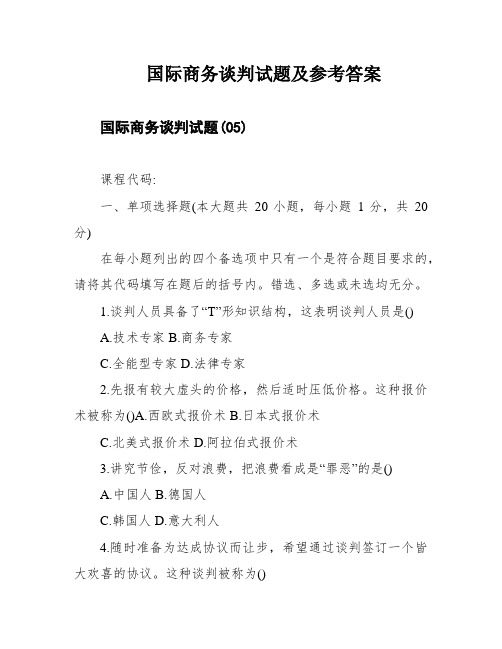
国际商务谈判试题及参考答案国际商务谈判试题(05)课程代码:一、单项选择题(本大题共20小题,每小题1分,共20分)在每小题列出的四个备选项中只有一个是符合题目要求的,请将其代码填写在题后的括号内。
错选、多选或未选均无分。
1.谈判人员具备了“T”形知识结构,这表明谈判人员是()A.技术专家B.商务专家C.全能型专家D.法律专家2.先报有较大虚头的价格,然后适时压低价格。
这种报价术被称为()A.西欧式报价术B.日本式报价术C.北美式报价术D.阿拉伯式报价术3.讲究节俭,反对浪费,把浪费看成是“罪恶”的是()A.中国人B.德国人C.韩国人D.意大利人4.随时准备为达成协议而让步,希望通过谈判签订一个皆大欢喜的协议。
这种谈判被称为()A.软式谈判B.硬式谈判C.原则型谈判D.价值型谈判5.一个谈判小组组长最佳的带领效益为()~4人~5人~6人~7人6.如果是1个小时的谈判,精神量旺盛的阶段只要最初的()~5分钟~6分钟~8分钟~9分钟7.谈判中,强调“一时多用”的是()A.瑞士人B.中东人C.德国人D.北美人8.下列选项中,不属于合同风险的是()A.交货风险B.质量风险C.数量风险D.会计风险9.与阿拉伯商人接触时不能赠送酒类礼品,由于饮酒在阿拉伯国家是被严厉禁止的。
这凸起反映的是商务谈判影响因素中的()A.政治状况因素B.法律制度因素C.商业惯因素D.社会俗因素10.在买卖做成之后,会举行一个长时间的宴会,请对方洗蒸气浴的是()A.中国人B.日本人C.韩国人D.芬兰人11.“按照贵方要求,我们的观点不是已经阐述清楚了吗?”这种商务谈判的发问类型属于()A.借助式发问B.探索式发问C.强调式发问D.澄清式发问12.下列选项中,不属于应对利率风险的技术手段是()A.使用远期交易B.使用平衡法C.利用期权交易D.利用利率期货市场13.在商务谈判中贯彻“有理、有利、有节”的目标。
这表现的是商务谈判的()A.平等互利原则B.灵活机动原则C.友好协商原则D.依法办事原则14.国际商务谈判计谋制定的第四步是()A.寻找枢纽问题B.肯定具体目标C.形成假设性方法D.形成具体谈判策略15.下列各项中,不属于善言灵巧的谈判对手的性格特征是()A.乐于交际B.容易激动C.擅长表达D.处世机灵16.眉毛上耸,表示此人处于()A.愤怒状态B.困窘状态C.戒备状态D.惊喜状态17.商务谈判中必须要实现的目标被称为()A.最低目标B.实际需求目标C.可接受目标D.最优期望目标18.在执行合同过程当中双方对合同条款理解不同而导致的僵局被称为()A.早期僵局B.执行期僵局C.协议期僵局D.中期僵局19.“贵方某师长教师的问题提得很好,我曾经在某一份资料上看过有关这一问题的记载,就记忆所及,大概是……”。
商务谈判考试简答题
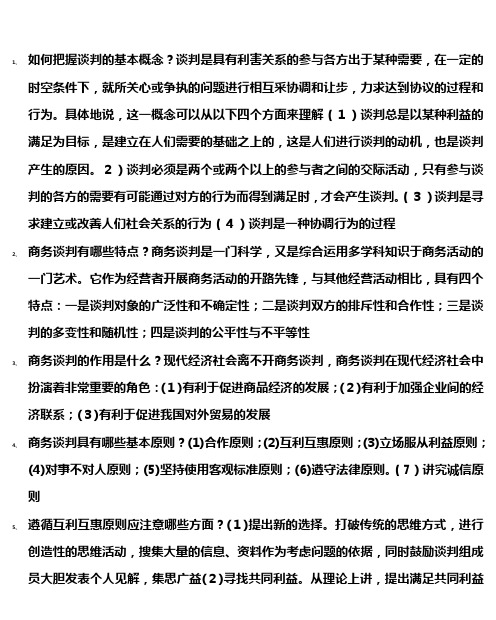
1、如何把握谈判的基本概念?谈判是具有利害关系的参与各方出于某种需要,在一定的时空条件下,就所关心或争执的问题进行相互采协调和让步,力求达到协议的过程和行为。
具体地说,这一概念可以从以下四个方面来理解(1)谈判总是以某种利益的满足为目标,是建立在人们需要的基础之上的,这是人们进行谈判的动机,也是谈判产生的原因。
2)谈判必须是两个或两个以上的参与者之间的交际活动,只有参与谈判的各方的需要有可能通过对方的行为而得到满足时,才会产生谈判。
(3)谈判是寻求建立或改善人们社会关系的行为(4)谈判是一种协调行为的过程2、商务谈判有哪些特点?商务谈判是一门科学,又是综合运用多学科知识于商务活动的一门艺术。
它作为经营者开展商务活动的开路先锋,与其他经营活动相比,具有四个特点:一是谈判对象的广泛性和不确定性;二是谈判双方的排斥性和合作性;三是谈判的多变性和随机性;四是谈判的公平性与不平等性3、商务谈判的作用是什么?现代经济社会离不开商务谈判,商务谈判在现代经济社会中扮演着非常重要的角色:(1)有利于促进商品经济的发展;(2)有利于加强企业间的经济联系;(3)有利于促进我国对外贸易的发展4、商务谈判具有哪些基本原则?(1)合作原则;(2)互利互惠原则;(3)立场服从利益原则;(4)对事不对人原则;(5)坚持使用客观标准原则;(6)遵守法律原则。
(7)讲究诚信原则5、遵循互利互惠原则应注意哪些方面?(1)提出新的选择。
打破传统的思维方式,进行创造性的思维活动,搜集大量的信息、资料作为考虑问题的依据,同时鼓励谈判组成员大胆发表个人见解,集思广益(2)寻找共同利益。
从理论上讲,提出满足共同利益的方案对双方都有好处,有助于达成协议。
尽管每一次合作都存在着共同利益,但是它们大部分是潜在的,需要谈判者去挖掘、发现,最好能用明确的语言和文字表达出来,以便谈判双方了解和掌握它(3)协调分歧利益。
利益上、观念上、时间上的分歧,都可以成为协调分歧的基础。
国际商务谈判--简答题

国际商务谈判简答题与论述题汇总第一章国际商务谈判概述(3-20):一、国际商务谈判的特殊性有哪些?P51.国际商务谈判既是一笔交易商洽,也是一项涉外活动,具有较强的政策性;2.应按国际惯例办事;3.国际商务谈判内容广泛;4.影响谈判的因素复杂多样。
二、国际商务谈判与一般贸易谈判的共性有哪些方面?P51.以经济利益为谈判的目的;2.以经济利益作为谈判的主要评价指标;3.以价格作为谈判的核心。
三、谈判准备工作的内容主要有哪些?P15~161.对谈判环境因素的分析;2.信息的收集;3.目标和对象的选择;4.谈判方案的制定;5.模拟谈判。
四、简述商务谈判的基本程序。
P15~171.准备阶段;2.开局阶段;3.正式谈判阶段;4.签约阶段。
五、简述PRAM谈判模式的构成。
P17~191.制定谈判计划;2.建立关系;3.达成使双方都能接受的协议;4.协议的履行与关系的维持。
第二章影响国际商务谈判的因素(25--57)2.经济的运行机制;3.政治背景;4.政局稳定性;5.政府间的关系。
2.外汇储备状况;3.货币的自由兑换;4.支付信誉;5.税法方面的情况。
1.群体成员的素质;2.群体成员的结构;3.群体规范;4.群体的决策方式;5.群体内的人际关系。
1.信心不足;2.热情过度;3.不知所措。
1、有利于摸清谈判对手的心理活动和心理特征,以便选择相应的谈判策略。
2、有利于了解己方谈判成员的心理活动和心理弱点,采取相应的措施进行调整和控制,保证己方2、灵活选择决策程序3、建立严明的纪律和有效地激励机制4、理顺群体内部信息交流的渠道第三章国际商务谈判前的准备(60-124)1.根据谈判对象确定组织规模;2.谈判人员赋予法人或法人代表资格;3.谈判人员应层次分明,分工明确;4.组成谈判队伍时要贯彻节约原则。
1.第一层次是谈判小组的领导人或首席代表,即主谈人;2.第二层次是专家和专业人员,还包括实际的核心人员翻译者,还有财经人员与法律人员;3.第三层次是谈判的必需工作人员,如速记或打字员。
国际商务谈判期末简答题

国际商务谈判期末简答题1、谈判的特点及构成要素。
特点:(1)谈判主体是相互独立的利益主体(2)谈判的目的是经济利益(3)谈判的中心议题是价格要素:(1)谈判主体(2)谈判议题(3)谈判背景2、提问的功能。
(1)引起他人的注意(2)取得情报(3)说明自己的感受,把消息传出给对方(4)让对方好好的去思考(5)归纳成结论3、谈判策略的作用。
(1)创造良好的开端(2)掌握前进的方向(3)控制谈判的进程(4)促进双方合作(5)保证理想的结局4、开局策略的基本要求。
(1)遵循开局的原则(2)探测对方情况,了解对方虚实(3)引起谈判对方的注意与兴趣(4)正确估计自己的能力(5)讲究“破冰”技巧(6)掌握谈判主动权5.谈判信息的作用有哪些?首先,谈判信息是制定谈判战略的依据;其次,谈判信息是控制谈判过程的手段;最后,谈判信息是谈判双方相互沟通的中介;6.与谈判有关的环境因素有哪几类?政治状况;宗教信仰;法律制度;商业习惯;社会习俗;财政金融状况;基础设施与后勤供应状况;气候状况;7.谈判准备工作的内容包括哪些?(1)对谈判环境因素的分析;(2)信息的收集;(3)目标和对象的选择;(4)谈判方案的制定;(5)模拟谈判;8.谈判中说服的技巧有哪些?(一)说服技巧的环节;(1)建立良好的人际关系,取得他人的信任;(2)分析你的意见可能导致的影响;(3)简化对方接受说服的程序;(二)说服技巧的要点:(1)站在他人的角度设身处地谈问题,不要只说自己的理由;(2)消除对方的戒心,创造良好的氛围。
9.简述商务谈判的价值评价标准。
商务谈判的价值评价标准有三方面:(1)、谈判的收益。
谈判收益是指谈判目标的实现程度。
具体来讲,在一个谈判中,谈判目标的实现程度是通过三个层次来体现的。
第一个层次是指具体的财务目标,赚多少利润;第二个层次是指远期的商务目标;第三个层次是指商务关系的维系。
(2分)(2)、谈判的效率高低。
谈判效率就是指谈判的收益与所费成本之间的比率。
国际商务谈判-简答题
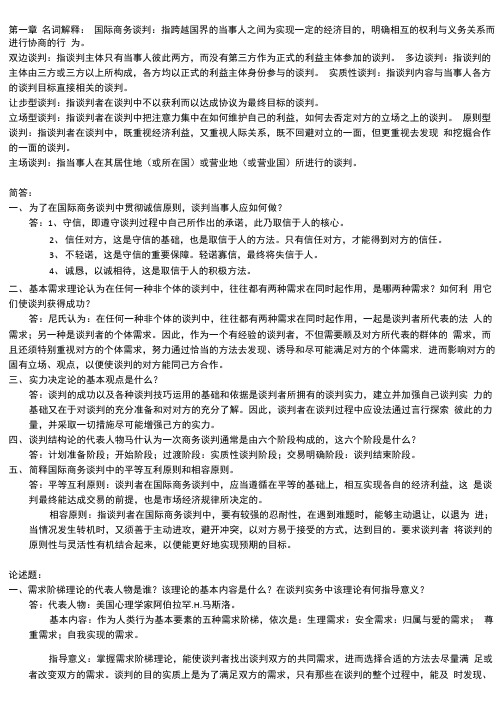
第一章名词解释:国际商务谈判:指跨越国界的当事人之间为实现一定的经济目的,明确相互的权利与义务关系而进行协商的行为。
双边谈判:指谈判主体只有当事人彼此两方,而没有第三方作为正式的利益主体参加的谈判。
多边谈判:指谈判的主体由三方或三方以上所构成,各方均以正式的利益主体身份参与的谈判。
实质性谈判:指谈判内容与当事人各方的谈判目标直接相关的谈判。
让步型谈判:指谈判者在谈判中不以获利而以达成协议为最终目标的谈判。
立场型谈判:指谈判者在谈判中把注意力集中在如何维护自己的利益,如何去否定对方的立场之上的谈判。
原则型谈判:指谈判者在谈判中,既重视经济利益,又重视人际关系,既不回避对立的一面,但更重视去发现和挖掘合作的一面的谈判。
主场谈判:指当事人在其居住地(或所在国)或营业地(或营业国)所进行的谈判。
简答:一、为了在国际商务谈判中贯彻诚信原则,谈判当事人应如何做?答:1、守信,即遵守谈判过程中自己所作出的承诺,此乃取信于人的核心。
2、信任对方,这是守信的基础,也是取信于人的方法。
只有信任对方,才能得到对方的信任。
3、不轻诺,这是守信的重要保障。
轻诺寡信,最终将失信于人。
4、诚恳,以诚相待,这是取信于人的积极方法。
二、基本需求理论认为在任何一种非个体的谈判中,往往都有两种需求在同时起作用,是哪两种需求?如何利用它们使谈判获得成功?答:尼氏认为:在任何一种非个体的谈判中,往往都有两种需求在同时起作用,一起是谈判者所代表的法人的需求;另一种是谈判者的个体需求。
因此,作为一个有经验的谈判者,不但需要顾及对方所代表的群体的需求,而且还须特别重视对方的个体需求,努力通过恰当的方法去发现、诱导和尽可能满足对方的个体需求, 进而影响对方的固有立场、观点,以便使谈判的对方能同己方合作。
三、实力决定论的基本观点是什么?答:谈判的成功以及各种谈判技巧运用的基础和依据是谈判者所拥有的谈判实力,建立并加强自己谈判实力的基础又在于对谈判的充分准备和对对方的充分了解。
国际商务谈判试题及答案
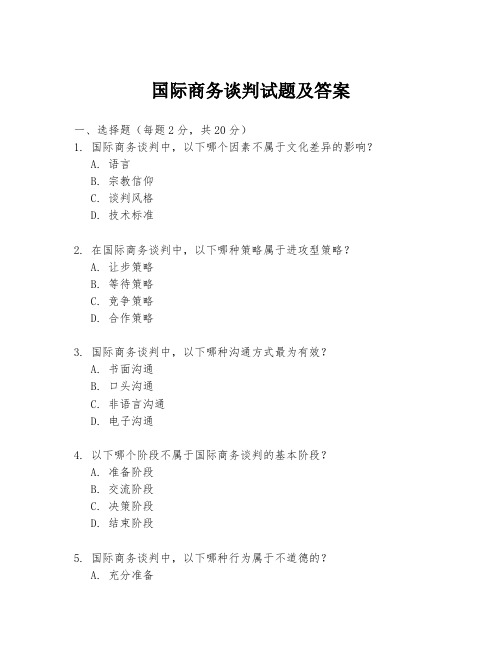
国际商务谈判试题及答案一、选择题(每题2分,共20分)1. 国际商务谈判中,以下哪个因素不属于文化差异的影响?A. 语言B. 宗教信仰C. 谈判风格D. 技术标准2. 在国际商务谈判中,以下哪种策略属于进攻型策略?A. 让步策略B. 等待策略C. 竞争策略D. 合作策略3. 国际商务谈判中,以下哪种沟通方式最为有效?A. 书面沟通B. 口头沟通C. 非语言沟通D. 电子沟通4. 以下哪个阶段不属于国际商务谈判的基本阶段?A. 准备阶段B. 交流阶段C. 决策阶段D. 结束阶段5. 国际商务谈判中,以下哪种行为属于不道德的?A. 充分准备B. 诚实守信C. 隐瞒信息D. 尊重对方6. 在国际商务谈判中,以下哪种情况最可能导致谈判失败?A. 双方需求一致B. 双方存在共同利益C. 双方互不信任D. 双方目标一致7. 国际商务谈判中,以下哪种文化因素对谈判影响最大?A. 饮食文化B. 礼仪文化C. 商业文化D. 娱乐文化8. 以下哪种谈判技巧不属于有效的谈判技巧?A. 倾听B. 观察C. 打断对方D. 反馈9. 在国际商务谈判中,以下哪种行为有助于建立良好的第一印象?A. 穿着随意B. 准时到达C. 迟到D. 忽视对方10. 国际商务谈判中,以下哪种策略是最为保守的?A. 冒险策略B. 稳健策略C. 激进策略D. 保守策略答案:1. D2. C3. B4. C5. C6. C7. C8. C9. B 10. D二、简答题(每题10分,共30分)1. 简述国际商务谈判中文化差异对谈判的影响。
答:国际商务谈判中的文化差异会对谈判过程产生显著影响。
不同的文化背景会导致谈判者在价值观、沟通方式、决策过程以及对时间的理解等方面存在差异。
这些差异可能影响谈判双方的相互理解,增加谈判的复杂性,并可能影响谈判结果。
2. 描述国际商务谈判中常见的几种谈判策略。
答:国际商务谈判中常见的谈判策略包括进攻型策略、防守型策略、合作型策略和妥协型策略。
国际商务谈判习题集
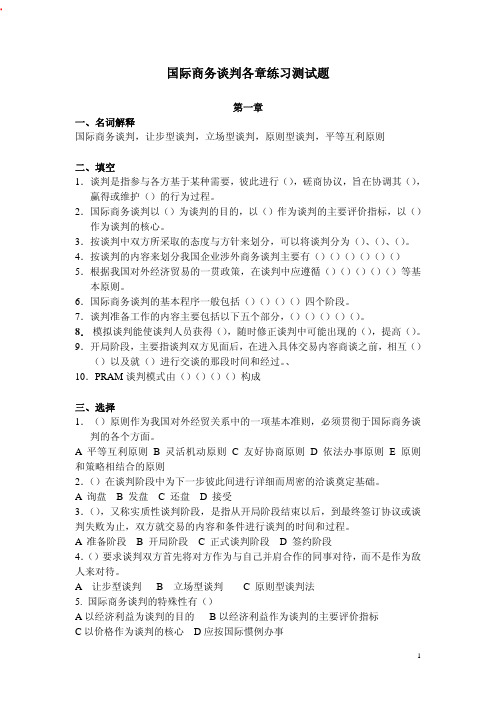
国际商务谈判各章练习测试题第一章一、名词解释国际商务谈判,让步型谈判,立场型谈判,原则型谈判,平等互利原则二、填空1.谈判是指参与各方基于某种需要,彼此进行(),磋商协议,旨在协调其(),赢得或维护()的行为过程。
2.国际商务谈判以()为谈判的目的,以()作为谈判的主要评价指标,以()作为谈判的核心。
3.按谈判中双方所采取的态度与方针来划分,可以将谈判分为()、()、()。
4.按谈判的内容来划分我国企业涉外商务谈判主要有()()()()()()5.根据我国对外经济贸易的一贯政策,在谈判中应遵循()()()()()等基本原则。
6.国际商务谈判的基本程序一般包括()()()()四个阶段。
7.谈判准备工作的内容主要包括以下五个部分,()()()()()。
8.模拟谈判能使谈判人员获得(),随时修正谈判中可能出现的(),提高()。
9.开局阶段,主要指谈判双方见面后,在进入具体交易内容商谈之前,相互()()以及就()进行交谈的那段时间和经过。
、10.PRAM谈判模式由()()()()构成三、选择1.()原则作为我国对外经贸关系中的一项基本准则,必须贯彻于国际商务谈判的各个方面。
A 平等互利原则B 灵活机动原则C 友好协商原则D 依法办事原则E 原则和策略相结合的原则2.()在谈判阶段中为下一步彼此间进行详细而周密的洽谈奠定基础。
A 询盘B 发盘C 还盘D 接受3.(),又称实质性谈判阶段,是指从开局阶段结束以后,到最终签订协议或谈判失败为止,双方就交易的内容和条件进行谈判的时间和过程。
A 准备阶段B 开局阶段C 正式谈判阶段D 签约阶段4.()要求谈判双方首先将对方作为与自己并肩合作的同事对待,而不是作为敌人来对待。
A 让步型谈判B 立场型谈判C 原则型谈判法5. 国际商务谈判的特殊性有()A以经济利益为谈判的目的B以经济利益作为谈判的主要评价指标C以价格作为谈判的核心D应按国际惯例办事6.不属于谈判的三项成本的是()A谈判桌上的成本B谈判过程的成本C谈判的机会成本D谈判前期准备成本7.价值型谈判指()A 让步型谈判B 立场型谈判C 原则型谈判法8.()即一般商品的买卖谈判,它主要是买卖双方就买卖货物本身的有关内容的谈判。
商务谈判简答题

商务谈判简答题:1.商务谈判应遵循哪些主要原则?(P28)⑴自愿原则,它是指作为谈判主体的当事各方,不是屈服于某种外来的压力和他人的驱使,而是出于自身利益目标的追求和互补互惠的意愿来参加谈判的。
自愿原则商务谈判的前提。
⑵平等原则,它是指商务谈判中无论各方的经济实力强、弱,组织规模大、小,其地位都是平等的。
平等原则是商务谈判的基础。
⑶互利原则,它是指谈判达成的协议对各方都是有利的。
互利是平等的客观要求和直接结果。
⑷求同原则,它是指谈判中面对利益分歧,从大局着眼,努力寻求共同的利益。
⑸效益原则,它是指商务谈判要重视效益,不仅要节约谈判成本,重视谈判自身效益,而且,也要重视谈判项目的社会效益。
⑹合法原则,它是指商务谈判必须遵守国家的法律、政策,国际商务谈判还应当遵循有关的国际法和对方国家的有关法规。
2.如何评价商务谈判的成败?评价商务谈判的成败,从根本上来说,就是要以效益原则为指导,既要考察谈判带来的经济利益,又要考察投入的谈判成本;既要考察经济效益,又要考察社会效益,以克服商务谈判中的单纯经济观点和短期行为,具体来说包括:⑴经济利益。
评价商务谈判的成败,不能离开交易各方可以获得的直接的经济利益,可以说交易各方获得饿经济利益的大小,是评价商务谈判成功与否的首要标准。
⑵谈判成本。
商务谈判是一个“给”与“取”兼而有之的过程。
为了获得期望的交易利益,也需要一定的投入,这种投入就是商务谈判的成本代价。
谈判成本包括费用成本和机会成本。
⑶社会效益,它是指商务谈判所产生的社会效果和社会反映。
社会效益包括多方面的内容,有些是有形的,有些是无形的;有些是可以计量的,更多是不能计量的,只能定性描述。
计量的指标形式不是以价格为量纲,多通过社会效果、社会声誉、社会福利等你来反映。
3.技术贸易中技术价格的确定受哪些因素的影响?(P46)⑴影响技术价格的因素,从转让方的角度,主要有以下方面:①技术开发费,指该技术设计、试验、制造等人力、物力消耗的成本②技术转让费,指为转让技术而发生的直接费用,包括接待考察费、技术资料费、咨询服务费、人员培训费等③利润损失补偿费指由于技术转让,转让方失去了利用该技术获取市场利润的机会和引进方使用该技术增加了转让方的竞争压力并缩小了转让方的商品市场而导致的利益损失的补偿。
国际商务谈判名词+简答2

1.中立地谈判:是指在谈判双方所在地以外的其他地点进行的谈判。
2.谈判信息:是指那些与谈判活动有密切联系的条件、情况及其属性的一种客观描述,是一种特殊的人工信息。
3.谈判策略:是在可以预见和可能发生的情况下应采取的相应的行动和手段。
4.国际商务谈判:是指在国际商务活动中,处于不同国家或不同地区的商务活动当事人为了达成某笔交易,彼此通过信息交流,就交易的各项要件进行协商的行为过程。
5.还盘:还盘是指受盘人在收到发盘之后,对其内容不完全同意,为了进一步磋商交易,向发盘人提出修改建议或一定限制性的意见,这种口头或书面的表示就是还盘,又称为还价。
6.日本式报价战术:讲最低价格列在价格表上,以求首先引起买主的兴趣,由于这种价格一般是以卖方最有利的结算条件为前提的,并且在这种低价格交易条件下,各个方面都很难全部满足买方的需要,如果买主要求改变有关条件,则卖主就会相应提高价格。
因此,买卖双方最后成交的价格往往高于价格表中的价格。
7.借助式发问:是一种借助第三者的意见来影响或改变对方意见的发问方式。
8.可接受谈判目标:是指在谈判中可努力争取或作出让步的范围,它能满足谈判一方的部分需求,实现部分经济利益。
9.投机风险:是指那些可能有损失也有可能获利的风险,如博彩、买卖股票等。
10横向谈判:把谈判的面撒开,先撇开争执的问题,再谈另一个问题,而不是盯住一个问题不放,不谈妥誓不罢休。
11.互惠式谈判:指谈判双方都要认定自身需要和对方需要,然后双方共同探讨满足彼此需要的一切有效地途径与办法。
12.协议期谈判僵局:谈判后期是双方达成协议的阶段,在已经解决了技术、价格等关键性问题之后还有诸如项目验收程序、付款条件等执行细节西药进一步商议,特别是合同条款的措辞、语气等经常容易引起的争议。
13.人员素质:商务谈判人员的个体素质只要是指谈判人员对与谈判有关的主客观情况的了解程度和解决在谈判中所遇到的问题的能力。
14.谈判实力:P7115.汇率风险:又称外汇风险,指经济主体持有或运用外汇的经济活动中,因汇率变动而蒙受损失的可能性。
国际商务谈判重点名词与简答

名词解释指参与各方为协调彼此的经济关系,满足贸易的需求,围绕标的物商务交易条件,通过信息交流、磋商协议达到交易目的的行为过程。
是指技术拥有方按商业交易的条件和方式,通过贸易谈判对技术需求方进行有偿技术和有关权利的转让,从而达到交易目的的行为过程。
沙龙式模拟:是把谈判者聚集在一起,充分讨论,自由发表意见,共同想象谈判全过程。
其模式是由高到低,事先提出一个有较大回旋余地的价格,而后根据谈判双方实力对比情况与该笔交易的国际市场竞争等因素,通过不同程度的优惠政策,如价格折扣、数量折扣、支付条款上的优惠 (延长其支付期限或提供信贷等) 等,慢慢软化谈判对手的立场和条件,最终达到成交的目的。
其一般模式是由低到高,报价时先报出最低价格,以吸引买主的谈判兴趣。
是指利用一些对对方具有吸引力或突发性的话题同对方交谈,或通过所谓的谣言、秘讯,或有意泄密等手段,借此琢磨和探测对方的态度和反应。
指通过疲劳战术来干扰对方的注意力,瓦解其意志并抓住有利时机达成协议。
是谈判人员为控制、调节谈判进程,缓和谈判气氛,打破谈判僵局而经常采用的一种基本策略。
或称伴随语言,指一些超出语言特征的附加现象,如声调、音量、音质等。
指在长期的商务谈判交往过程中,满足迎合文化的适应性而形成的行为或活动的规范。
简答开局阶段、报价阶段、磋商阶段、妥协阶段、成交阶段。
①开局阶段是进入正式谈判的节奏,谈判双方通过相互了解熟悉,为以后的正式谈判做好准备。
②报价阶段是谈判的正式开始阶段,报价应该坚定、明确,且不加任何解释和说明。
③磋商阶段是谈判的主旋律,基本摸清双方谈判的临界点和争取点,也就搞清楚了协议区所在。
④妥协阶段是经过磋商之后,谈判开始进入柳暗花明、水落石出的阶段。
各方已经把握了可能妥协的范围,开始寻求一一妥协的途径。
⑤成交阶段是谈判的最后阶段。
经过妥协,各方对一致同意的妥协方案表示认可,并以文字形成协议书,由各方代表签字使其具有法律效力,必要时还须进行公证。
国际商务谈判 简答题

第一章名词解释:国际商务谈判:指跨越国界的当事人之间为实现一定的经济目的,明确相互的权利与义务关系而进行协商的行为。
双边谈判:指谈判主体只有当事人彼此两方,而没有第三方作为正式的利益主体参加的谈判。
多边谈判:指谈判的主体由三方或三方以上所构成,各方均以正式的利益主体身份参与的谈判。
实质性谈判:指谈判内容与当事人各方的谈判目标直接相关的谈判。
让步型谈判:指谈判者在谈判中不以获利而以达成协议为最终目标的谈判。
立场型谈判:指谈判者在谈判中把注意力集中在如何维护自己的利益,如何去否定对方的立场之上的谈判。
原则型谈判:指谈判者在谈判中,既重视经济利益,又重视人际关系,既不回避对立的一面,但更重视去发现和挖掘合作的一面的谈判。
主场谈判:指当事人在其居住地(或所在国)或营业地(或营业国)所进行的谈判。
简答:一、为了在国际商务谈判中贯彻诚信原则,谈判当事人应如何做答:1、守信,即遵守谈判过程中自己所作出的承诺,此乃取信于人的核心。
2、信任对方,这是守信的基础,也是取信于人的方法。
只有信任对方,才能得到对方的信任。
3、不轻诺,这是守信的重要保障。
轻诺寡信,最终将失信于人。
4、诚恳,以诚相待,这是取信于人的积极方法。
二、基本需求理论认为在任何一种非个体的谈判中,往往都有两种需求在同时起作用,是哪两种需求如何利用它们使谈判获得成功答:尼氏认为:在任何一种非个体的谈判中,往往都有两种需求在同时起作用,一起是谈判者所代表的法人的需求;另一种是谈判者的个体需求。
因此,作为一个有经验的谈判者,不但需要顾及对方所代表的群体的需求,而且还须特别重视对方的个体需求,努力通过恰当的方法去发现、诱导和尽可能满足对方的个体需求,进而影响对方的固有立场、观点,以便使谈判的对方能同己方合作。
三、实力决定论的基本观点是什么答:谈判的成功以及各种谈判技巧运用的基础和依据是谈判者所拥有的谈判实力,建立并加强自己谈判实力的基础又在于对谈判的充分准备和对对方的充分了解。
国际商务谈判试题及参考答案
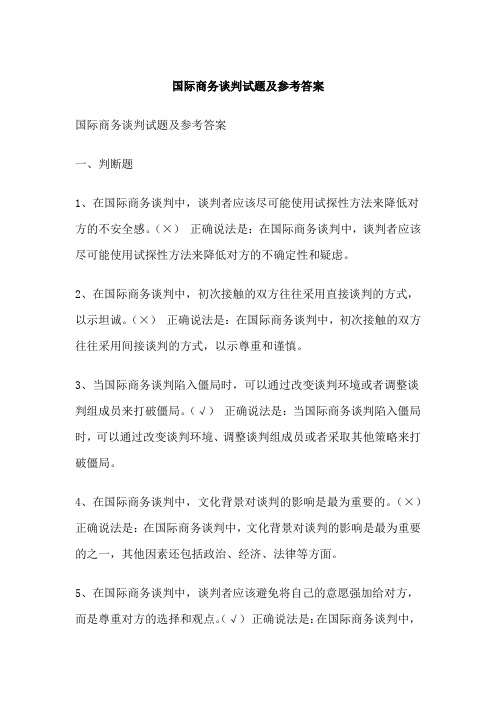
国际商务谈判试题及参考答案国际商务谈判试题及参考答案一、判断题1、在国际商务谈判中,谈判者应该尽可能使用试探性方法来降低对方的不安全感。
(×)正确说法是:在国际商务谈判中,谈判者应该尽可能使用试探性方法来降低对方的不确定性和疑虑。
2、在国际商务谈判中,初次接触的双方往往采用直接谈判的方式,以示坦诚。
(×)正确说法是:在国际商务谈判中,初次接触的双方往往采用间接谈判的方式,以示尊重和谨慎。
3、当国际商务谈判陷入僵局时,可以通过改变谈判环境或者调整谈判组成员来打破僵局。
(√)正确说法是:当国际商务谈判陷入僵局时,可以通过改变谈判环境、调整谈判组成员或者采取其他策略来打破僵局。
4、在国际商务谈判中,文化背景对谈判的影响是最为重要的。
(×)正确说法是:在国际商务谈判中,文化背景对谈判的影响是最为重要的之一,其他因素还包括政治、经济、法律等方面。
5、在国际商务谈判中,谈判者应该避免将自己的意愿强加给对方,而是尊重对方的选择和观点。
(√)正确说法是:在国际商务谈判中,谈判者应该尊重对方的选择和观点,并通过沟通和协商来达成双赢的解决方案。
二、选择题1、下列哪个国家在国际商务谈判中倾向于采用直接谈判方式?(A)A. 美国B. 日本C. 德国D. 法国正确答案是:A. 美国。
美国人在商务谈判中倾向于采用直接、坦率的谈判方式,注重效率和质量。
2、下列哪一项不是文化背景对国际商务谈判的影响?(D) A. 语言沟通 B. 社交礼仪 C. 价值观 D. 产品标准正确答案是:D. 产品标准。
产品标准是根据行业标准或国际标准制定的,不受文化背景的影响。
3、在国际商务谈判中,下列哪个因素是最不重要的?(C) A. 文化背景 B. 政治环境 C. 个人性格 D. 经济条件正确答案是:C. 个人性格。
个人性格对谈判的影响相对较小,而文化背景、政治环境和经济条件等因素对谈判的影响更为重要。
4、下列哪个国家在国际商务谈判中倾向于采用间接谈判方式?(B)A. 美国B. 日本C. 德国D. 法国正确答案是:B. 日本。
国际商务谈判试题附详细答案
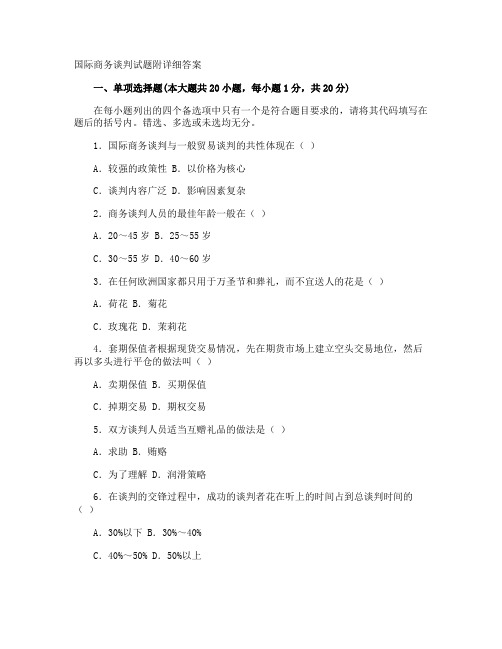
国际商务谈判试题附详细答案一、单项选择题(本大题共20小题,每小题1分,共20分)在每小题列出的四个备选项中只有一个是符合题目要求的,请将其代码填写在题后的括号内。
错选、多选或未选均无分。
1.国际商务谈判与一般贸易谈判的共性体现在()A.较强的政策性 B.以价格为核心C.谈判内容广泛 D.影响因素复杂2.商务谈判人员的最佳年龄一般在()A.20~45岁 B.25~55岁C.30~55岁 D.40~60岁3.在任何欧洲国家都只用于万圣节和葬礼,而不宜送人的花是()A.荷花 B.菊花C.玫瑰花 D.茉莉花4.套期保值者根据现货交易情况,先在期货市场上建立空头交易地位,然后再以多头进行平仓的做法叫()A.卖期保值 B.买期保值C.掉期交易 D.期权交易5.双方谈判人员适当互赠礼品的做法是()A.求助 B.贿赂C.为了理解 D.润滑策略6.在谈判的交锋过程中,成功的谈判者花在听上的时间占到总谈判时间的()A.30%以下 B.30%~40%C.40%~50% D.50%以上7.无论穿什么,都不会把手放到口袋里,因为这样做会被认为是粗鲁的。
具有这种行为习惯的是()A.德国人 B.美国人C.韩国人 D.日本人8.在国际商务谈判中,认为手帕象征亲人离别,是不祥之物,不能送人的国家是()A.美国 B.英国C.法国 D.意大利9.商务谈判成为必要是由于交易中存在()A.冲突 B.攻击C.合作 D.辩论10.从法律学角度来讲,其结果是终局性的是()A.协商 B.调解C.仲裁 D.诉讼11.在一支谈判队伍中,负责对交易标的物的品质进行谈判的是()A.技术人员 B.法律人员C.商务人员 D.谈判领导人12.若我方在谈判中实力较强,可采取的外汇风险防范方法是()A.硬货币计价法 B.对等易货贸易法C.约定货币保值条款 D.汇率风险分摊条款13.“对这个问题,我虽没有调查过,但曾经听说过。
”这种答复谈判对手的技巧是()A.避正答偏 B.答非所问C.以问代答 D.推卸责任14.在国际商务谈判中,往往会不断地点头,但并非表示“同意”。
国际商务谈判简答题
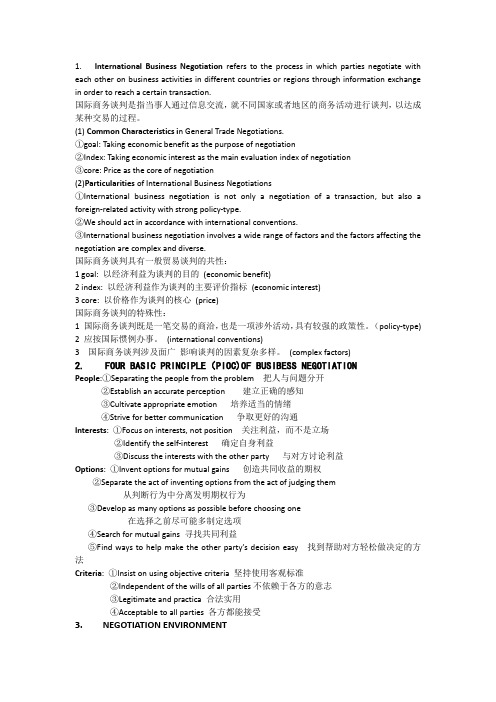
1. International Business Negotiation refers to the process in which parties negotiate with each other on business activities in different countries or regions through information exchange in order to reach a certain transaction.国际商务谈判是指当事人通过信息交流,就不同国家或者地区的商务活动进行谈判,以达成某种交易的过程。
(1) Common Characteristics i n General Trade Negotiations.①goal: Taking economic benefit as the purpose of negotiation②Index: Taking economic interest as the main evaluation index of negotiation③core: Price as the core of negotiation(2)Particularities of International Business Negotiations①International business negotiation is not only a negotiation of a transaction, but also a foreign-related activity with strong policy-type.②We should act in accordance with international conventions.③International business negotiation involves a wide range of factors and the factors affecting the negotiation are complex and diverse.国际商务谈判具有一般贸易谈判的共性:1 goal: 以经济利益为谈判的目的(economic benefit)2 index: 以经济利益作为谈判的主要评价指标(economic interest)3 core: 以价格作为谈判的核心(price)国际商务谈判的特殊性:1 国际商务谈判既是一笔交易的商洽,也是一项涉外活动,具有较强的政策性。
国际商务谈判(参考题及答案

答案:(1)会导致谈判破裂或损害中方利益的结果。(2)应该指派具有相应专业知识和能力的商务人员、技术人员和法律人 员替换原小组中的3名政府官员参与谈判。(3)国际商务谈判中有关谈判组织结构的理论。
3.如何准备国际商务谈判?
答案:主要从以下几个方面准备国际商务谈判:(1)谈判背景的调查,包括谈判对手的政治状况、经济状况、政策和法律、宗 教信仰、社会习俗和商业习惯基础设施和后勤供应系统、一国的基础状况、后勤供应和自然资源和气候都会影响商务谈判活动; (2)谈判对手的调查。主要考虑对手身份身份、主体资格、谈判的时限、谈判的信息情况和真正需求等因素;(3)谈判资料的 收集和筛选。应该收集包括市场信息、行业状况、产品资料等相关信息,通过对资料的评价、筛选、和分类,获取有用的相关信 息。(4)明确谈判目标。从实用性、合理性和合法性出发明确谈判目标的层次,最终实现谈判目标的优化。(5)进行谈判的 时空选择。需综合考虑谈判议程的安排、地点的选择和座次的安排等因素。(6)制定合理的谈判方案。根据谈判方案的基本要 求明确谈判的基本策略,选择最优谈判方案。(7)进行模拟谈判,及早发现谈判方案中的问题,提出解决的对策,掌握谈判的 主动权
4.商务礼仪
答案:在商务活动中,为了体现相互尊重,需要通过一些行为准则去约束人们在商务活动中的方方面面,这其中包括仪表礼仪, 言谈举止,书信来往,电话沟通等技巧,从商务活动的场合又可以分为办公礼仪,宴会礼仪,迎宾礼仪等。
二、简答题 1.谈谈你对商务谈判心理的理解?
答响印心案,象、:比,协如需调把说要性握色留、商彩下创务、良造谈气好性判温的、心、第自理位一制需置印力要、象、了谈、意解判把志对桌握力方的人、的选际幽包择吸默括、引感生谈规和理判律良需地,好要点还的、的要心安选克态全择服。需和认要处知、理偏社个见交体,需空做要间出、时客尊需观重要判需考断要虑;;的锻要问炼考题国虑;际物掌商理握务环谈谈境判判对心心谈理理判,素人需质员要包心处括理理责的好任影
国际商务谈判简答
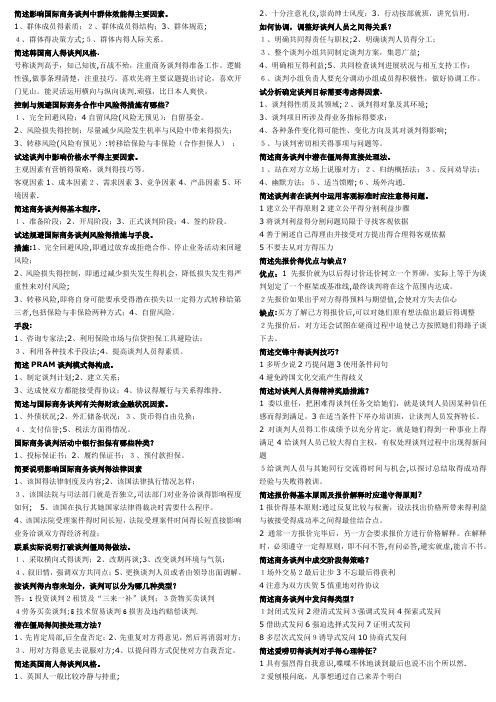
简述影响国际商务谈判中群体效能得主要因素。
1、群体成员得素质;2、群体成员得结构;3、群体规范;4、群体得决策方式;5、群体内得人际关系。
简述韩国商人得谈判风格.号称谈判高手,知己知彼,百战不殆,注重商务谈判得准备工作。
逻辑性强,做事条理清楚,注重技巧。
喜欢先将主要议题提出讨论,喜欢开门见山。
能灵活运用横向与纵向谈判.顽强,比日本人爽快。
控制与规避国际商务合作中风险得措施有哪些?1、完全回避风险;4自留风险(风险无预见):自留基金。
2、风险损失得控制:尽量减少风险发生机率与风险中带来得损失;3、转移风险(风险有预见):转移给保险与非保险(合作担保人);试述谈判中影响价格水平得主要因素。
主观因素有营销得策略,谈判得技巧等。
客观因素1、成本因素2、需求因素3、竞争因素4、产品因素5、环境因素.简述商务谈判得基本程序。
1、准备阶段;2、开局阶段;3、正式谈判阶段;4、签约阶段。
试述规避国际商务谈判风险得措施与手段。
措施:1、完全回避风险,即通过放弃或拒绝合作、停止业务活动来回避风险;2、风险损失得控制,即通过减少损失发生得机会,降低损失发生得严重性来对付风险;3、转移风险,即将自身可能要承受得潜在损失以一定得方式转移给第三者,包括保险与非保险两种方式;4、自留风险。
手段:1、咨询专家法;2、利用保险市场与信贷担保工具避险法;3、利用各种技术手段法;4、提高谈判人员得素质。
简述PRAM谈判模式得构成。
1、制定谈判计划;2、建立关系;3、达成使双方都能接受得协议;4、协议得履行与关系得维持.简述与国际商务谈判有关得财政金融状况因素。
1、外债状况;2、外汇储备状况;3、货币得自由兑换;4、支付信誉;5、税法方面得情况。
国际商务谈判活动中银行担保有哪些种类?1、投标保证书;2、履约保证书;3、预付款担保。
简要说明影响国际商务谈判得法律因素1、该国得法律制度及内容;2、该国法律执行情况怎样;3、该国法院与司法部门就是否独立,司法部门对业务洽谈得影响程度如何; 5、该国在执行其她国家法律得裁决时需要什么程序。
- 1、下载文档前请自行甄别文档内容的完整性,平台不提供额外的编辑、内容补充、找答案等附加服务。
- 2、"仅部分预览"的文档,不可在线预览部分如存在完整性等问题,可反馈申请退款(可完整预览的文档不适用该条件!)。
- 3、如文档侵犯您的权益,请联系客服反馈,我们会尽快为您处理(人工客服工作时间:9:00-18:30)。
一、需求阶梯理论的代表人物是谁?该理论的基本内容是什么?在谈判实务中该理论有何指导意义?
答:代表人物:美国心理学家阿伯拉罕.H.马斯洛。
基本内容:作为人类行为基本要素的五种需求阶梯,依次是:生理需求;安全需求;归属与爱的需求;尊重需求;自我实现的需求。
指导意义:掌握需求阶梯理论,能使谈判者找出谈判双方的共同需求,进而选择合适的方法去尽量满足或者改变双方的需求。谈判的目的实质上是为了满足双方的需求,只有那些在谈判的整个过程中,能及时发现、全面掌握、恰当解决、尽量顾及双方需求的谈判者,才会掌握谈判的主动权,才会取得谈判的成功,才能真正获得自己的需求。
让步型谈判:指谈判者在谈判中不以获利而以达成协议为最终目标的谈判。
立场型谈判:指谈判者在谈判中把注意力集中在如何维护自己的利益,如何去否定对方的立场之上的谈判。
原则型谈判:指谈判者在谈判中,既重视经济利益,又重视人际关系,既不回避对立的一面,但更重视去发现和挖掘合作的一面的谈判。
主场谈判:指当事人在其居住地(或所在国)或营业地(或营业国)所进行的谈判。
2、实践性较强。国际商务谈判实务的内容是通过研究、剖析有关国际商务谈判中的一些带规律性的技能和事项,使读者学习后,能把所学知识用来指导自己的实践,懂得如何正确地进行国际商务谈判,并不断提高自己从事国际商务谈判的能力。
3、策略性较强。国际商务谈判实务就是研究在谈判中,谈判者应如何在熟练掌握有关谈判的内容、法律及政策规定的基础上,灵活而又有效地运用策略的问题。
二、基本需求理论的代表人物是谁?何谓基本需求?基本需求理论所强调的是什么?
答:代表人物:尼尔龙伯格。
基本需求:人们在每次行为时,通常只考虑那些尚未满足且与自己的能力可及的需求,这种需求就是其基本需求。
所强调的是:谈判的前提是谈判各方均希求从谈判中得到某种基本需求,而此种基本需求既不是已经满足或者很容易就能得到满足的需求,也不是无法得到满足或者希望渺茫的需求,而是尚未得到而又可望得到满足的需求,并且此种基本需求中既包括群体的需求,也包括谈判者作为个体的需求。只有那些设法抓住对方的基本需求并因势利导的谈判者,才有可能取得谈判的成功。
简答:
一、为了在国际商务谈判中贯彻诚信原则,谈判当事人应如何做?
答:1、守信,即遵守谈判过程中自己所作出的承诺,此乃取信于人的核心。
2、信任对方,这是守信的基础,也是取信于人的方法。只有信任对方,才能得到对方的信任。
3、不轻诺,这是守信的重要保障。轻诺寡信,最终将失信于人。
4、诚恳,以诚相待,这是取信于人的积极方法。
答:通过我驻所在国(地)外交机构商务处(组)或驻外商务机构是最为可靠和便捷的方式。
第三章
简答题:
一、简述英国商人从事商务活动的作风。
答:英国商人从事商务活动的作风比世界其他国家商人更重视正规,也更为保守。他们更愿意事前作好充分准备,然后进行面对面商谈。他们高傲,但不失分寸,善于克制,极少当面争执,但遇到纠纷又毫不让步,不会轻易认错,一切均得按规矩办。英国商人谈判认真,不会因为催促而改变节奏。很重视地位。
第二章
名词解释迎接大型代表团或大型庆典多采用此形式。招待会又有酒会、冷餐会等。
简答题:
一、来华客商要求参观考察工厂或生产基地,中方该如何接待?
答:1、在门前或引人注目处贴一欢迎标语,更重要的是准备好中外文的公司简介和产品简介。
2、客商到达后,接到会客室,奉上茶水,介绍基本情况。
三、实力决定论的基本观点是什么?
答:谈判的成功以及各种谈判技巧运用的基础和依据是谈判者所拥有的谈判实力,建立并加强自己谈判实力的基础又在于对谈判的充分准备和对对方的充分了解。因此,谈判者在谈判过程中应设法通过言行探索彼此的力量,并采取一切措施尽可能增强己方的实力。
四、谈判结构论的代表人物马什认为一次商务谈判通常是由六个阶段构成的,这六个阶段是什么?
三、原则谈判法有哪些主要观点?
答:1、要将人与问题分开,在谈判中要对事不对人。
2、要将谈判重点放在利益上而非放在立场上。
3、要构思彼此有利的解决方案。
4、要坚持客观标准,根据价值和公平的标准去达成协议。
四、国际商务谈判的特点有哪些?
答:1、法律法强。国际商务谈判本身是一种法律行为,首先必须符合法律规范的要求,才能得到法律的承认和保护。
第一章
名词解释:
国际商务谈判:指跨越国界的当事人之间为实现一定的经济目的,明确相互的权利与义务关系而进行协商的行为。
双边谈判:指谈判主体只有当事人彼此两方,而没有第三方作为正式的利益主体参加的谈判。
多边谈判:指谈判的主体由三方或三方以上所构成,各方均以正式的利益主体身份参与的谈判。
实质性谈判:指谈判内容与当事人各方的谈判目标直接相关的谈判。
二、基本需求理论认为在任何一种非个体的谈判中,往往都有两种需求在同时起作用,是哪两种需求?如何利用它们使谈判获得成功?
答:尼氏认为:在任何一种非个体的谈判中,往往都有两种需求在同时起作用,一起是谈判者所代表的法人的需求;另一种是谈判者的个体需求。因此,作为一个有经验的谈判者,不但需要顾及对方所代表的群体的需求,而且还须特别重视对方的个体需求,努力通过恰当的方法去发现、诱导和尽可能满足对方的个体需求,进而影响对方的固有立场、观点,以便使谈判的对方能同己方合作。
3、引导客人参观生产流程等。
4、参观完毕后,可送一份小礼物做纪念。
二、请解释名片在左下几种缩写的含义?1、P.C;2、P.R;3、P.P;4、P.P.C;5、P.S
答:1、P.C:谨唁;2、P.R:谨谢;3、P.P:介绍;4、P.P.C:辞行;5、P.F.N.A:恭贺新禧。
三、如果首次和谈判对手打交道,了解对方资信最便捷最可靠的方式是什么?
答:计划准备阶段;开始阶段;过渡阶段;实质性谈判阶段;交易明确阶段;谈判结束阶段。
五、简释国际商务谈判中的平等互利原则和相容原则。
答:平等互利原则:谈判者在国际商务谈判中,应当遵循在平等的基础上,相互实现各自的经济利益,这是谈判最终能达成交易的前提,也是市场经济规律所决定的。
相容原则:指谈判者在国际商务谈判中,要有较强的忍耐性,在遇到难题时,能够主动退让,以退为进;当情况发生转机时,又须善于主动进攻,避开冲突,以对方易于接受的方式,达到目的。要求谈判者将谈判的原则性与灵活性有机结合起来,以便能更好地实现预期的目标。
